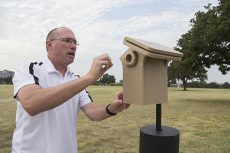By Tabitha Redder/ reporter
NE Campus’ smaller attendees recently gained recognition all their own.
After lengthy documentation, the Texas Parks and Wildlife Department declared the campus a Wildlife Demonstration Site.

A demonstration site provides food, water and shelter that is easily accessible to native wildlife.
NE kinesiology associate professor Tim Sebesta initiated the process.
“I’m a bird enthusiast. I like birds,” he said. “So what I started doing over the last year was documenting all the birds I’ve seen here on campus.”
Then, partnering with facilities manager John Tilley and lead groundskeeper Renee Peacock, they also documented all the campus plant life.
“We looked at what was required for the [demonstration site] application, made sure we met it, and while we didn’t put down every single thing, we actually added an extra spreadsheet that listed even more than what was required,” Sebesta said.
Tilley said the landscape includes both natives and non-natives while emphasizing water and resource conservation.
“Just by chance, we had installed a lot of this stuff over the years, so it was kind of just a happy coincidence,” he said. “I did a natural landscape that would attract butterflies and hummingbirds and worked on a fragrant garden so it would have different types of scents throughout the year.”
Sebesta previously received this certification at a different location, so he knew NE Campus would be a good candidate to qualify.

Photos by Katelyn Townsend/The Collegian
“There’s a lot going on on this campus as it relates to biodiversity,” Sebesta said. “But what we were looking for was the habitat — the plants, shrubs and trees that would provide a natural food source for animals, different mammals and birds.”
Peacock has incorporated native grasses like muhly and maiden grasses into the campus landscape where native Turk’s caps and salvias already attracted pollinators like bees and hummingbirds.
“The butterflies thrive here,” she said. “The landscaping has been set up so they not only feed and pollinate here, but they live here.”
Peacock also credited the pond on campus for providing a more diverse atmosphere.
“The pond is a place where these ducks and geese can live, but we incorporate it so it’s still safe for the students,” she said. “You have a more natural, park-like atmosphere for people to be in and study in.”
In addition to benefiting local wildlife, the demonstration site recognition also benefits the community.
“Let’s say a local elementary school wants to know where they can go to learn about wildlife and nature,” Sebesta said. “Our campus would be a location they could come to.”

